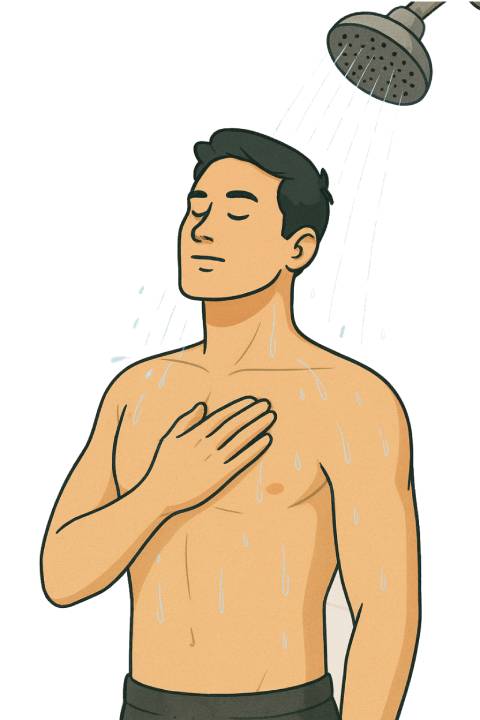Every instinct tells us to avoid freezing cold water – so why are so many people willingly jumping into it? The answer lies in its powerful benefits, everything from improved circulation to bulletproof mental resilience. This guide aims to break down how to safely and effectively incorporate cold water exposure into your routine so you too can hop on the bandwagon.
Note: Cold water exposure carries inherent risks, including hypothermia, shock, and loss of consciousness. Always practice caution, listen to your body, and avoid prolonged exposure to extreme cold. If you have any medical conditions or concerns, consult a healthcare professional before attempting cold water exposure. Never practice in unsafe environments (e.g. open water alone). This guide is for informational purposes only and does not constitute medical advice.

What is Cold Water Exposure? 🧠
Cold water exposure is what it says on the tin: subjecting the body to cold temperatures to stimulate a response. This can be done using several methods, but this guide mainly covers:
- Cold Showers: Convenient and beginner-friendly.
- Ice Baths: Immersing the body in ice-cold water for a set duration.
Physical Benefits of Cold Water Exposure
- Improved Circulation
- Cold water causes vasoconstriction as you enter the water (blood vessels constrict to preserve heat) followed by vasodilation as you exit and dry off (blood vessels widen), improving blood flow and oxygen delivery throughout the body.
- Cold water causes vasoconstriction as you enter the water (blood vessels constrict to preserve heat) followed by vasodilation as you exit and dry off (blood vessels widen), improving blood flow and oxygen delivery throughout the body.
- Reduced Inflammation & Faster Recovery
- Cold exposure lowers inflammation, which can help muscles recover faster after intense exercise.
- Cold exposure lowers inflammation, which can help muscles recover faster after intense exercise.
- Activation of Brown Fat & Metabolism Boost
- Short-Term: Cold exposure forces the body to burn more calories to maintain core temperature.
- Long-Term: Regular exposure activates brown fat which burns energy to generate heat, potentially increasing overall metabolic rate.
It only takes a few minutes to see these benefits and the effects compound over time.
Mental Benefits of Cold Water Exposure
- Dopamine Boost (Mood, Motivation & Energy)
- Cold exposure triggers a large, prolonged release of dopamine, a chemical in the brain responsible for motivation, mood, and focus.
- This dopamine increase lasts for hours, unlike dopamine spikes from social media and so on. This leads to sustained benefits and a less noticeable ‘comedown’.
- Increased Mental Resilience & Stress Tolerance
- Training your mind to endure discomfort strengthens your ability to handle stress and difficult situations in daily life.
- Exposing yourself to small, controlled stressors makes you more resilient to bigger stressors.
- Regular cold exposure lowers baseline stress levels by improving your nervous system’s ability to shift between stress and relaxation states more efficiently.
- Increased Norepinephrine Release
- Cold exposure spikes norepinephrine (a chemical in the brain), leading to:
- Improved focus and mental clarity
- Increased mood regulation
- Cold exposure spikes norepinephrine (a chemical in the brain), leading to:
- Emotional Regulation & Anxiety Reduction
- Cold exposure activates the parasympathetic nervous system after the initial shock, promoting calmness and emotional stability. This can help reduce anxiety and be a good mindset reset.
Best Practices For Cold Water Exposure ➡️
To get the most out of cold exposure, you’re going to want to follow some best practices to ensure effectiveness and safety.
How to Do Cold Water Exposure Safely
The number 1 priority.
- Start Gradually: Begin with shorter durations and less extreme temperatures
- Monitor Health Conditions: Individuals with cardiovascular issues or other health concerns should consult a healthcare professional before trying cold exposure
- Avoid Hazardous Conditions: Steer clear of dangerous bodies of water with strong currents, extreme temperatures, or unsafe access points
What is the Optimal Temperature for Cold Water Exposure?
- Choose a temperature that feels intensely cold but manageable – you should feel the strong urge to get out, but still be in control.
- You want that sharp, stinging sensation on the skin as that’s a good indicator that the water is cold enough to trigger the benefits.
- It’s unlikely that your shower will ever be too cold, so work towards that coldest setting as a goal
- For ice baths, aim for 5-10°C (41-50°F). If you don’t have anything to measure temperature, follow the guidelines above, start at something you can manage and work your way up.
What is the Optimal Duration for Cold Water Exposure?
- Target 2-3 minutes per session for effectiveness, but shorter is fine if the water is extremely cold.
- Sessions over 3 minutes tend to have diminishing returns on benefits (unless it’s mental strength you’re targeting)
- Aim for 10-15 minutes of total exposure per week, spread over multiple sessions.
- Listen to your body – shivering is fine, but if you start feeling numb, lightheaded, or uncontrollably shaking, exit immediately.
Tip: Start small. The most difficult part of cold water exposure is simply ‘getting in’. If you find yourself skipping sessions, reduce the planned duration to just 10-20 seconds. Practice being comfortable with the feeling of ‘getting in’, then gradually increase the duration to the effective time as you adapt.
The Huberman Lab Approach for Cold Water Exposure
Dr Andrew Huberman suggests a unique mental strategy for cold exposure:
- Counting Walls: Think of the desire to exit the cold as a ‘wall’
- Instead of timing yourself, aim to overcome a specific number of walls (e.g. 5 moments of wanting to quit)
- This approach builds mental resilience and shifts focus away from discomfort
Movement During Cold Water Exposure
- Don’t stay still! If you remain motionless, a thermal layer (a thin insulating layer of warmer water) forms around your body, making it easier.
- Move slightly (shift weight, gently sway arms, or contract muscles) to disrupt this layer and increase the intensity of exposure.
- Avoid hunching – keep your posture open and breathe deeply to regulate your response.
When is the Best Time to Do Cold Water Exposure?
- You can do cold water exposure most times of the day, but some of the benefits such as focus and alertness may be most useful in the mornings or before a workout.
- Avoid before bed: Cold exposure can cause a post-exposure heat response, potentially disrupting sleep.
- Not after weight training: If your goal is muscle/strength gains, regular ice baths or cold showers post workout can blunt muscle growth adaptations

FAQs💡
How should I breathe during cold exposure?
You should feel your breath quicken as you enter the cold water, especially if you are new to cold exposure. Try to get your breathing under control as soon as possible, aiming for slow inhales through the nose and slower exhales through the mouth. This trains your body to relax in stressful environments and can transfer to other areas of life.
Closing Thoughts 📌
Cold water exposure is a bit of a life hack – it’s simple, effective, practically free, and available to pretty much everyone. This article should have given you everything you need to start building it into your routine, and for something with such accessible benefits, I genuinely think it deserves a place in everyone’s habits.
The hardest part is always right before getting in, your brain will resist, procrastinate, and come up with every excuse. But once you’re in, it’s an instant mood lift and a powerful reset button during the day, especially if you need to refocus or boost your energy. And of course, the list of long-term benefits is pretty extensive too. Just don’t go to extremes, don’t overdo it, consistency is key.
Stay frosty ❄️
Notes 📝
Notes
What are the optimal durations for different goals? eg. for an extreme athlete would you want longer than 3 mins for recovery?
Research suggests that frequent post-workout ice baths (especially within 1-2 hours after training) can reduce muscle protein synthesis and hypertrophy.
One study (Peake et al., 2017) found that chronic post-workout cold exposure led to smaller gains in muscle size and strength over time compared to non-cold-exposed groups.
A study by Roberts et al. (2015) showed that cold water immersion impaired muscle protein synthesis and satellite cell activation, both of which are crucial for muscle growth.
However, cold showers have a lesser impact than full ice baths because they don’t lower muscle temperature as drastically.
Further Reading
This is pretty comprehensive and is where a lot of the info in this guide is summarised from.



